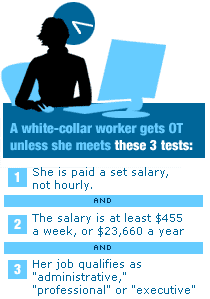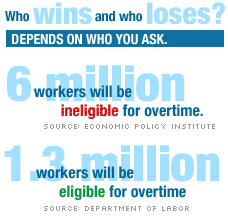NEW YORK (CNN/Money) - Don't know if you're owed overtime pay? You're not alone.
On Monday, new federal rules detailing which workers get time-and-a-half and which ones don't are due to take effect. The changes mark the first major overhaul of the federal overtime law in more than 50 years. In response, employers and employees alike are scrambling to figure out what they mean.
With some 500 pages of legalese to pore over, the task isn't easy.
In a nutshell, the revamped regulations are easy to comprehend if your yearly income is roughly under $23,000, or if you take home more than $100,000 a year. For middle-income workers, however, understanding the rules can trigger a migraine.
The basic idea behind the Fair Labor Standards Act holds that workers in so-called "white collar" jobs can, under certain instances, earn extra pay for workweeks that exceed 40 hours.
Under the law, there are three primary tests for determining who is eligible ("non-exempt") and who is not ("exempt") from overtime pay.
Pay and job duties matter most
First up is the "salary-basis" test. To be exempt from overtime, workers must be paid a set salary, not an hourly wage. This has long been the rule under federal overtime law. The new rules don't change this requirement.
 |
|
| Understanding overtime rules is not as easy as it looks. |
The second criterion, called the "salary-level" test, has been amended. In order to be exempt from overtime, the new rules require that employees earn a minimum salary of $455 a week, or $23,660 a year. That's triple the prior minimum salary of $155 a week, or $8,060 a year.
White-collar employees who earn more than $100,000 a year are automatically exempt from overtime pay under the new law. That wasn't the case before, although many high-income workers have been exempt for other reasons besides their income level.
The third test is where the rules get considerably more complicated -- and controversial. The final prong is called the "duties" test. It tries to establish eligibility based on the type of work an employee performs every day. Under federal law, a worker whose job is deemed "administrative," "professional," or "executive" in nature does not qualify for overtime. The categories themselves won't change.
Instead, the new rules aim to clarify the type of work that qualifies as administrative, professional and executive. For example, under the executive exemption, a fast food manager must be involved in key staffing decisions like hiring, firing and promoting in order to be deemed ineligible for overtime. Previously, that manager had to have the actual power to hire and fire employees in order to be considered exempt.
Who's considered a "professional"? According to the Department of Labor, which issued the new guidelines, a professional can't get overtime if she has a job that is "primarily intellectual" and requires "discretion and judgment."
These include "learned" professionals such as lawyers, doctors, registered nurses and engineers. But technicians, beauticians, licensed practical nurses, and other "skilled tradespeople" are owed time-and-a-half. So too are firefighters, police sargeants and other emergency personnel deemed to be "first responders."
Confused? Look on the bright side: the previous rules spelled out these and other exemptions in roughly 30,000 words. The new guidelines take only 13,000.
A Herculean effort
Every administration since President Jimmy Carter's has tried to simplify overtime rules, whose last major revision was in 1949 and, until now, discussed such obsolete jobs as "straw bosses," "gang leaders" and "legmen."
 |
|
| Few labor issues are as polarizing as overtime rights. |
But given the stakes -- millions of dollars in annual overtime pay -- neither employers nor labor unions could agree on a compromise solution. Intense lobbying on both sides blocked past reform efforts.
The climate changed dramatically in the late 1990s. Workers started suing employers for denying them overtime and winning multimillion dollar payouts. In 2001, the litigation wave captured national attention when a California jury ordered Farmers Insurance Exchange to pay $90 million for failing to pay time and half to its insurance adjusters.
Employees have since hauled Wal-Mart, Blockbuster, Home Depot and Starbucks, among other major corporations, into court. On the enforcement side, regulators collected in 2003 a record $212.5 million in back wages from employers who violated wage-and-hour laws -- a 20 percent increase from 2002, another peak year.
The Bush administration is hoping to stem the litigation flood. But the new rules are proving to be no less controversial than before. Democrats in Congress, led by Sen. Tom Harkin, D-Iowa, have fiercely opposed the revisions and pledged to block them from taking effect, a threat whose chance of success increases considerably if Democrats reclaim the White House in November.
Last month, the Economic Policy Institute announced that 6 million workers will lose their right to overtime under the new rules. Labor Secretary Elaine Chao counters that 1.3 million employees will now be eligible for overtime and that the new rules strengthen protections for 5.4 million others.
The Labor Department estimates that businesses will pay $739 million to comply with the law and an additional $375 million in annual payroll fees. On the flip side, the agency projects that companies will save $252.2 million a year on the assumption that they will commit fewer violations of wage-and-hour laws.
J. Craig Shearman, the vice-president for government affairs at the National Retail Federation, said retailers, which have been hit hard with lawsuits, are pleased with the new rules. Among other things, he said they simplify overtime classifications by relying less on job titles and more on actual duties.
"We're very happy to see the update," he said.
Labor unions, meanwhile, vow to continue waging battles for overtime pay in court.
Another factor that could dampen the impact of the new regs is state law. Some 18 states, including California and Illinois, have separate overtime laws that trump federal law, according to Amy Bess, an employment law partner at Sonnenschein Nath & Rosenthal in Washington, D.C.
That's an important distinction. California, where state law makes it far easier for workers to qualify for time and a half, has become the hotbed of overtime litigation. Federal rules, old or new, won't change that.

|

